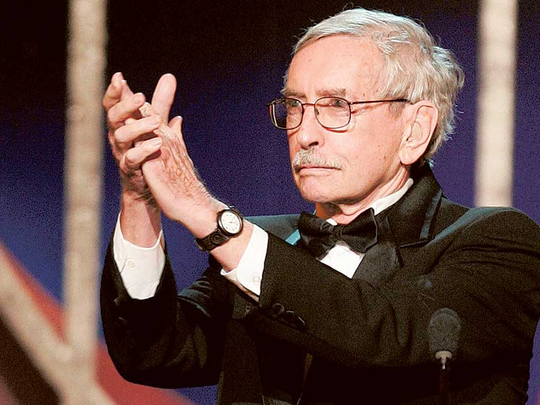
New York: Edward Albee, widely considered the foremost American playwright of his generation — whose psychologically astute and piercing dramas explored the contentiousness of intimacy, the gap between self-delusion and truth, and the roiling desperation beneath the facade of contemporary life — died Friday at his home in Montauk, New York. He was 88.
His personal assistant, Jakob Holder, confirmed the death. Holder said he had died after a short illness.
Albee introduced himself suddenly and with a bang, in 1959, when his first produced play, “The Zoo Story,” opened in Berlin on a double bill with Samuel Beckett’s “Krapp’s Last Tape.” A two-handed one-act that unfolds in real time, “The Zoo Story” zeroed in on the existential terror at the heart of Eisenhower-era complacency, presenting the increasingly menacing intrusion of a probing, querying stranger on a man reading on a Central Park bench.
When the play came to the Provincetown Playhouse in Greenwich Village the next year, it helped propel the burgeoning theatre movement that became known as off-Broadway.
In 1962, Albee’s Broadway debut, “Who’s Afraid of Virginia Woolf?,” a famously scabrous portrait of a withered marriage, won a Tony Award for best play. It shocked theatergoers with its depiction of stifling academia and of a couple whose relationship has been corroded by dashed hopes, wounding recriminations and drink.
The 1966 film adaptation, directed by Mike Nichols and starring Richard Burton and Elizabeth Taylor, turned the play into Albee’s most famous work; it had, he wrote three decades later, “hung about my neck like a shining medal of some sort — really nice but a trifle onerous.”
But it stands as representative, too, an early example of the heightened naturalism he often ventured into, an expression of the viewpoint that self-interest is a universal, urgent, irresistible and poisonous agent in modern life — “There’s nobody doesn’t want something,” a character of his said — that Albee would illustrate again and again with characteristically pointed eloquence.
A half-century later, Albee’s audacious drama about a love affair between man and beast, “The Goat, or Who Is Sylvia?,” won another Tony, ran for nearly a year and staved off the critical despair, however briefly, that the commercial theatre could no longer support serious drama.
In between, Albee (his name is pronounced AWL-bee) turned out a parade of works, 30 or so in all, generally focused on exposing the darkest secrets of relatively well-to-do people, with lacerating portrayals of familial relations, social intercourse and individual soul-searching. Beyond his Tonys — including one for lifetime achievement — he won three Pulitzer Prizes.
As Ben Brantley of The New York Times once wrote, “Albee has unsparingly considered subjects outside the average theatre-goer’s comfort zone: the capacity for sadism and violence within American society; the fluidness of human identity; the dangerous irrationality of sexual attraction and, always, the irrefutable presence of death.”
His major works included “A Delicate Balance,” a darkly unsettling comedy about an affluent family whose members reveal their deep unhappiness in shrewd and stinging verbal combat; “All Over” (1971), directed on Broadway by John Gielgud and starring Colleen Dewhurst, about a family (and a mistress) awaiting the deathbed expiration of an unseen, wealthy man; “Seascape” (1975), a creepily comic, slightly ominous meditation on monogamy, evolution and mortality that develops from an oceanside discussion involving an elderly human couple and a pair of anthropomorphic lizards; and “Three Tall Women,” a strikingly personal work drawn from memories of his adoptive mother, scrutinising, in its various stages, the life of a dying woman.
“All of my plays are about people missing the boat, closing down too young, coming to the end of their lives with regret at things not done, as opposed to things done,” he said in a 1991 New York Times interview. “I find most people spend too much time living as if they’re never going to die.”
Albee was born somewhere in Virginia on March 12, 1928. Little is known about his father. His mother’s name was Louise Harvey; she called him Edward. Sent to an adoption nursery in New York before he was three weeks old, baby Edward was placed with Reed Albee, an heir to the Keith-Albee chain of vaudeville theatres, and his wife, Frances, who lived in Larchmont, New York.
Albee lived for several decades in a Manhattan loft filled with African sculptures and contemporary paintings by the likes of Vuillard, Milton Avery and Kandinsky. His partner of 35 years, Jonathan Thomas, a sculptor, died in 2005. Albee leaves no immediate survivors.
— New York Times News Service












